Model and Data Concur and Explain the Coexistence of Two Very Distinct Animal Behavioral Types
Abstract
:1. Introduction
2. Material and Methods
2.1. The Model
2.1.1. Model Assumptions
2.1.2. Modeling Algorithm
2.1.3. Model Parameterization
2.2. Simulations
Field Data: Do the Simulated Strategies Coexist in the Wild?
3. Results
3.1. Ecological Scenarios for the Maintenance of Strategies
3.2. Frequency-Dependent Equilibria
3.3. The Evolution of Strategies—The Invasion of Novel Mutations
Field Data: Do the Simulated Strategies Coexist in the Wild?
4. Discussion
4.1. Ecological Determinants of the Frequency-Dependent Equilibrium
4.2. Behavioral Syndromes and Behavioral Plasticity
5. Conclusions
Supplementary Materials
Author Contributions
Funding
Acknowledgments
Conflicts of Interest
References
- Lande, R. Natural Selection and Random Genetic Drift in Phenotypic Evolution. Evolution 1976, 30, 314–334. [Google Scholar] [CrossRef] [PubMed]
- West-Eberhard, M. Developmental Plasticity and Evolution; Oxford University Press: New York, NY, USA, 2003. [Google Scholar]
- Bolnick, D.; Svanbäck, R.; Fordyce, J.; Yang, L.; Davis, J.; Hulsey, C.; Forister, M. The Ecology of Individuals: Incidence and Implications of Individual Specialization. Am. Nat. 2003, 161, 1–28. [Google Scholar] [CrossRef] [PubMed]
- Bolnick, D.; Amarasekare, P.; Araújo, M.; Bürger, R.; Levine, J.; Novak, M.; Rudolf, V.; Schreiber, S.; Urban, M.; Vasseur, D. Why intraspecific trait variation matters in community ecology. Trends Ecol. Evol. 2011, 26, 183–192. [Google Scholar] [CrossRef] [PubMed] [Green Version]
- Des Roches, S.; Post, D.; Turley, N.; Bailey, J.; Hendry, A.; Kinnison, M.; Schweitzer, J.; Palkovacs, E. The ecological importance of intraspecific variation. Nat. Ecol. Evol. 2018, 2. [Google Scholar] [CrossRef] [PubMed]
- Raffard, A.; Santoul, F.; Cucherousset, J.; Blanchet, S. The community and ecosystem consequences of intraspecific diversity: A meta-analysis. Biol. Rev. 2018, 94. [Google Scholar] [CrossRef]
- Moya-Laraño, J.; Bilbao-Castro, J.; Barrionuevo Rosales, G.; Ruiz-Lupión, D.; Casado, L.G.; Montserrat, M.; Melian, C.; Magalhaes, S. Eco-Evolutionary Spatial Dynamics: Rapid Evolution and Isolation Explain Food Web Persistence. Adv. Ecol. Res. 2014, 50, 75–143. [Google Scholar] [CrossRef]
- Schoener, T. The Newest Synthesis: Understanding the Interplay of Evolutionary and Ecological Dynamics. Science 2011, 331, 426–429. [Google Scholar] [CrossRef]
- Yoshida, T.; Ellner, S.; Jones, L.; Bohannan, B.; Lenski, R.; Hairston, N. Cryptic Population Dynamics: Rapid Evolution Masks Trophic Interactions. PLoS Biol. 2007, 5, e235. [Google Scholar] [CrossRef]
- Roff, D. Evolutionary Quantitative Genetic. In Evolutionary Quantitative Genetics; Springer US: New York, NY, USA, 1997; Volume 2, p. 493. ISBN 0-412-12971-X. [Google Scholar]
- Dingemanse, N.; Wolf, M. Between-individual differences in behavioural plasticity within populations: Causes and consequences. Anim. Behav. 2013, 85, 1031–1039. [Google Scholar] [CrossRef]
- Sih, A.; Bell, A.; Johnson, J.; Robert, Z. Behavioral syndromes: An integrative overview. Q. Rev. Biol. 2004, 79, 241–277. [Google Scholar] [CrossRef]
- Sih, A.; Bell, A.; Johnson, J. Behavioral syndrome: An ecological and evolutionary overview. Trends Ecol. Evol. 2004, 19, 372–378. [Google Scholar] [CrossRef] [PubMed] [Green Version]
- Bell, A. Future directions in behavioural syndromes research. Proc. Biol. Sci. 2007, 274, 755–761. [Google Scholar] [CrossRef] [PubMed] [Green Version]
- Sih, A.; Cote, J.; Evans, M.; Fogarty, S.; Pruitt, J. Ecological implications of behavioural syndromes. Ecol. Lett. 2012, 15, 278–289. [Google Scholar] [CrossRef] [PubMed]
- Wolf, M.; Weissing, F. Animal personalities: Consequences for ecology and evolution. Trends Ecol. Evol. 2012, 27, 452–461. [Google Scholar] [CrossRef] [PubMed]
- Réale, D.; Reader, S.; Sol, D.; McDougall, P.; Dingemanse, N. Integrating animal temperament within ecology and evolution. Biol. Rev. Camb. Philos. Soc. 2007, 82, 291–318. [Google Scholar] [CrossRef] [PubMed] [Green Version]
- Réale, D.; Garant, D.; Humphries, M.; Bergeron, P.; Careau, V.; Montiglio, P.-O. Personality and the emergence of the pace-of-life syndrome concept at the population level. Philos. Trans. R. Soc. Lond. B Biol. Sci. 2010, 365, 4051–4063. [Google Scholar] [CrossRef] [Green Version]
- Maynard-Smith, J. Evolution and the Theory of Games; Cambridge University Press: Cambridge, UK, 1982; ISBN 9780521288842. [Google Scholar]
- Maynard-Smith, J.; Harper, D. The Evolution of Aggression: Can Selection Generate Variability? [and Discussion]. Philos. Trans. R. Soc. Lond. B Biol. Sci. 1988, 319, 557–570. [Google Scholar] [CrossRef]
- Wolf, M.; van Doorn, S.; Weissing, F. Evolutionary emergence of responsive and unresponsive personalities.Evolutionary emergence of responsive and unresponsive personalities. Proc. Natl. Acad. Sci. USA 2008, 105, 15825–15830. [Google Scholar] [CrossRef] [Green Version]
- Wolf, M.; Mcnamara, J.; Wolf, M.; McNamara, J.M. On the evolution of personalities via frequency-dependent selection. Am. Nat. 2012, 179, 679–692. [Google Scholar] [CrossRef] [Green Version]
- Wolf, M.; Weissing, F. An explanatory framework for adaptive personality differences. Philos. Trans. R. Soc. Lond. B Biol. Sci. 2010, 365, 3959–3968. [Google Scholar] [CrossRef]
- Bell, A. Behavioural differences between individuals and two populations of stickleback (Gasterosteus aculeatus). J. Evol. Biol. 2005, 18, 464–473. [Google Scholar] [CrossRef] [PubMed]
- Dingemanse, N.; Wright, J.; Kazem, A.; Thomas, D.; Hickling, R.; Dawnay, N. Behavioural syndromes differ predictably between 12 populations of three-spined stickleback. J. Anim. Ecol. 2007, 76, 1128–1138. [Google Scholar] [CrossRef] [PubMed]
- Dingemanse, N.; Kazem, A.; Réale, D.; Wright, J. Behavioural reaction norms: Animal personality meets individual plasticity. Trends Ecol. Evol. 2010, 25, 81–89. [Google Scholar] [CrossRef] [PubMed]
- Dingemanse, N.; Bouwman, K.; van de Pol, M.; Overveld, T.; Patrick, S.; Matthysen, E.; Quinn, J. Variation in personality and behavioural plasticity across four populations of the great tit Parus major. J. Anim. Ecol. 2012, 81, 116–126. [Google Scholar] [CrossRef]
- Elgar, M. Sexual cannibalism in spiders and other invertebrates. In Cannibalism: Ecology and Evolution among Diverse Taxa; Oxford University Press: Oxford, UK, 1992; ISBN 0198546505. [Google Scholar]
- Elgar, M.; Schneider, J. Evolutionary Significance of Sexual Cannibalism. In Advances in The Study of Behavior; Elsevier: Amsterdam, The Netherlands, 2004; Volume 34, pp. 135–163. [Google Scholar]
- Arnqvist, G.; Henriksson, S. Sexual cannibalism in fishing spider and a model for the evolution of sexual cannibalism based on genetic constraints. Evol. Ecol. 1997, 11, 255–273. [Google Scholar] [CrossRef]
- Johnson, J.; Sih, A. Fear, food, sex and parental care: A syndrome of boldness in the fishing spider, Dolomedes triton. Anim. Behav. 2007, 74, 1131–1138. [Google Scholar] [CrossRef]
- Johnson, J.; Sih, A. Precopulatory sexual cannibalism in fishing spiders (Dolomedes triton): A role for behavioral syndromes. Behav. Ecol. Sociobiol. 2005, 58, 390–396. [Google Scholar] [CrossRef]
- Kralj-Fišer, S.; Schneider, J.; Kuntner, M.; Hauber, M. Challenging the Aggressive Spillover Hypothesis: Is Pre-Copulatory Sexual Cannibalism a Part of a Behavioural Syndrome? Ethology 2013, 119. [Google Scholar] [CrossRef]
- Moya-Laraño, J.; Pascual, J.; Wise, D. Mating patterns in late-maturing female Mediterranean tarantulas may reflect the costs and benefits of sexual cannibalism. Anim. Behav. 2003, 66, 469–476. [Google Scholar] [CrossRef] [Green Version]
- Rabaneda-Bueno, R.; Aguado, S.; Fernández-Montraveta, C.; Moya-Laraño, J. Does female personality determine mate choice through sexual cannibalism? Ethology 2014, 120. [Google Scholar] [CrossRef]
- Riechert, S.; Hedrick, A. A test for correlations among fitness-linked behavioural traits in the spider Agelenopsis aperta (Araneae, Agelenidae). Anim. Behav. 1993, 46, 669–675. [Google Scholar] [CrossRef] [Green Version]
- Kralj-Fišer, S.; Čandek, K.; Lokovšek, T.; Čelik, T.; Cheng, R.-C.; Elgar, M.; Kuntner, M. Mate choice and sexual size dimorphism, not personality, explain female aggression and sexual cannibalism in raft spiders. Anim. Behav. 2016, 111. [Google Scholar] [CrossRef]
- Newman, J.; Elgar, M. Sexual Cannibalism in Orb-Weaving Spiders: An Economic Model. Am. Nat. 1991, 138, 1372–1395. [Google Scholar] [CrossRef]
- Moya-Laraño, J.; Orta-Ocaña, J.; José Antonio, B.; Bach, C.; Wise, D. Intriguing compensation by adult female spiders for food limitation experienced as juveniles. Oikos 2003, 101, 539–548. [Google Scholar] [CrossRef] [Green Version]
- Barry, K.; Holwell, G.; Herberstein, M. Female praying mantids use sexual cannibalism as a foraging strategy to increase fecundity. Behav. Ecol. 2008, 19, 710–715. [Google Scholar] [CrossRef] [Green Version]
- Gavín Centol, P.; Kralj-Fišer, S.; De Mas Castroverde, E.; Ruiz-Lupión, D.; Moya-Laraño, J. Feeding regime, adult age and sexual size dimorphism as determinants of pre-copulatory sexual cannibalism in virgin wolf spiders. Behav. Ecol. Sociobiol. 2017, 71. [Google Scholar] [CrossRef]
- Wilder, S.; Rypstra, A. Sexual size dimorphism mediates the occurrence of state-dependent sexual cannibalism in a wolf spider. Anim. Behav. 2008, 76, 447–454. [Google Scholar] [CrossRef]
- Rabaneda-Bueno, R.; Rodríguez-Gironés, M.; Aguado, S.; Fernández-Montraveta, C.; De Mas Castroverde, E.; Wise, D.; Moya-Laraño, J. Sexual Cannibalism: High Incidence in a Natural Population with Benefits to Females. PLoS ONE 2008, 3, e3484. [Google Scholar] [CrossRef] [Green Version]
- Johnson, J. Sexual cannibalism in fishing spiders (Dolomedes triton): An evaluation of two explanations for female aggression towards potential mates. Anim. Behav. 2001, 61, 905–914. [Google Scholar] [CrossRef] [Green Version]
- Erez, T.; Schneider, J.M.; Lubin, Y. Is Male Cohabitation Costly for Females of the Spider Stegodyphus lineatus (Eresidae)? Ethology 2005, 111, 693–704. [Google Scholar] [CrossRef]
- Dingemanse, N.; Both, C.; Drent, P.; Tinbergen, J. Fitness consequences of avian personalities in a fluctuating environment. Proc. Biol. Sci. 2004, 271, 847–852. [Google Scholar] [CrossRef] [PubMed]
- Dingemanse, N.; Réale, D. Natural selection and animal personality. Behaviour 2005, 142. [Google Scholar] [CrossRef]
- Smith, B.; Blumstein, D. Fitness consequences of personality: A meta-analysis. Behav. Ecol. 2008, 19, 448–455. [Google Scholar] [CrossRef] [Green Version]
- Moya-Laraño, J. Senescence and food limitation in a slowly aging spider. Funct. Ecol. 2002, 16, 734–741. [Google Scholar] [CrossRef] [Green Version]
- Moya-Laraño, J.; Orta-Ocana, J.; José Antonio, B.; Bach, C.; Wise, D. Territoriality in a Cannibalistic Burrowing Wolf Spider. Ecology 2002, 83, 356–361. [Google Scholar] [CrossRef]
- Biro, P.; Abrahams, M.; Post, J.; Parkinson, E. Behavioural trade offs between growth and mortality explain evolution of submaximal growth rates. J. Anim. Ecol. 2006, 75, 1165–1171. [Google Scholar] [CrossRef]
- DeAngelis, D.L.; Mooij, W.M. Individual-Based Modeling of Ecological and Evolutionary Processes. Annu. Rev. Ecol. Evol. Syst. 2005, 36, 147–168. [Google Scholar] [CrossRef]
- Deangelis, D.; Grimm, V. Individual-based models in ecology after four decades. F1000Prime Rep. 2014, 6, 39. [Google Scholar] [CrossRef] [Green Version]
- Grimm, V.; Berger, U.; Bastiansen, F.; Eliassen, S.; Ginot, V.; Giske, J.; Goss-Custard, J.; Grand, T.; Heinz, S.; Huse, G.; et al. A Standard Protocol for Describing Individual-Based and Agent Based Models. Ecol. Modell. 2006, 198, 115–126. [Google Scholar] [CrossRef]
- Planas, E.; Fernández-Montraveta, C.; Ribera, C. Molecular systematics of the wolf spider genus Lycosa (Araneae: Lycosidae) in the Western Mediterranean Basin. Mol. Phylogenet. Evol. 2013, 67. [Google Scholar] [CrossRef]
- Riechert, S.; Maynard-Smith, J. Genetic analyses of two behavioural traits linked to individual fitness in the desert spider Agelenopsis aperta. Anim. Behav. 1989, 37, 624–637. [Google Scholar] [CrossRef]
- Král, J.; Musilová, J.; Stahlavsky, F.; Rezác, M.; Akan, Z.; Edwards, R.; Coyle, F.; Ribera, C. Evolution of the karyotype and sex chromosome systems in basal clades of araneomorph spiders (Araneae: Araneomorphae). Chromosome Res. 2006, 14, 859–880. [Google Scholar] [CrossRef] [PubMed]
- Fernandez-Montraveta, C.; Ortega, J. Sex differences in the agonistic behaviour of a lycosid spider (Araneae Lycosidae). Ethol. Ecol. Evol. 1993, 5, 293–301. [Google Scholar] [CrossRef]
- Elgar, M. Sperm Competition and Sexual Selection in Spiders and Other Arachnids. In Sperm Competition and Sexual Selection; Academic Press: Cambridge, MA, USA, 1998; pp. 307–339. ISBN 9780121005436. [Google Scholar]
- Orta, J.M.; Moya-Laraño, J.; Barrientos, J.A. Datos fenológicos de una población de Lycosa tarantula fasciiventris L. Dufour, 1835, en el Noroeste de la Península Ibérica (Araneae, Lycosidae). Bolletino Accad. Gioenia Sci. Nat. 1993, 26, 15–26. [Google Scholar]
- Uhl, G.; Gunnarsson, B. Female genitalia in Pityohyphantes phrygianus, a spider with a skewed sex ratio. J. Zool. 2001, 255, 367–376. [Google Scholar] [CrossRef]
- Jakob, E.; Marshall, S.; Uetz, G.; Jakob, E.M.; Marshall, S.D.; Uetz, G.W. Estimating fitness: A comparison of body condition indices. Oikos 1996, 77, 61. [Google Scholar] [CrossRef] [Green Version]
- Moya-Laraño, J.; Pascual, J.; Wise, D. Approach Strategy by which Male Mediterranean Tarantulas Adjust to the Cannibalistic Behaviour of Females. Ethology 2004, 110, 717–724. [Google Scholar] [CrossRef]
- Moya-Laraño, J. Limitación por el Alimento, Territorialidad y Canibalismo en la Tarántula Mediterránea, Lycosa tarentula (L.) (Araneae, Lycosidae). Ph.D. Thesis, Universitat Autònoma de Barcelona, Barcelona, Spain, 1999. [Google Scholar]
- Moya-Laraño, J.; Macías-Ordóñez, R.; Blanckenhorn, W.; Fernández-Montraveta, C. Analysing body condition: Mass, volume or density? J. Anim. Ecol. 2008, 77, 1099–1108. [Google Scholar] [CrossRef]
- Higgins, E.; Rankin, A. Mortality risk of rapid growth in the spider Nephila clavipes. Funct. Ecol. 2001, 15, 24–28. [Google Scholar] [CrossRef]
- Uetz, G. Foraging strategies of spiders. Trends Ecol. Evol. 1992, 7, 155–159. [Google Scholar] [CrossRef]
- Prokop, P.; Václav, R. Seasonal aspects of sexual cannibalism in the praying mantis (Mantis religiosa). J. Ethol. 2008, 26, 213–218. [Google Scholar] [CrossRef]
- Samu, F.; Toft, S.; Kiss, B.; Samu, F.; Toft, S.; Kiss, B. Factors influencing cannibalism in the wolf spider Pardosa agrestis (Araneae, Lycosidae). Behav. Ecol. Sociobiol. 1999, 45, 349–354. [Google Scholar] [CrossRef]
- Wise, D. Spiders in Ecological Webs; Cambridge University Press: Cambridge, UK, 1993. [Google Scholar] [CrossRef]
- Rabaneda-Bueno, R. El Canibalismo Sexual en la Tarántula Ibérica (Lycosa hispanica): Ecología y Evolución de Estrategias Conductuales. Ph.D. Thesis, Autonomous University of Madrid, Madrid, Spain, 2014. [Google Scholar]
- R Core Development Team. R: A Language and Environment for Statistical Computing; R Core: Vienna, Austria, 2014. [Google Scholar]
- Luttbeg, B.; Sih, A. Risk, resources and state-dependent adaptive behavioural syndromes. Philos. Trans. R. Soc. Lond. B Biol. Sci. 2010, 365, 3977–3990. [Google Scholar] [CrossRef] [PubMed] [Green Version]
- Moya-Laraño, J.; Verdeny-Vilalta, O.; Rowntree, J.; Melguizo-Ruiz, N.; Montserrat, M.; Laiolo, P. Climate Change and Eco-Evolutionary Dynamics in Food Webs. Adv. Ecol. Res. 2012, 47, 1–80. [Google Scholar] [CrossRef]
- Morse, D. A test of sexual cannibalism models, using a sit-and-wait predator. Biol. J. Linn. Soc. 2004, 81, 427–437. [Google Scholar] [CrossRef] [Green Version]
- Morse, D. Mating frequencies of male crab spiders, Misumena vatia (Araneae, Thomisidae). J. Arachnol. 2007, 35, 84–88. [Google Scholar] [CrossRef]
- Legrand, R.; Morse, D. Factors driving extreme sexual size dimorphism of a sit-and-wait predator under low density. Biol. J. Linn. Soc. 2008, 71, 643–664. [Google Scholar] [CrossRef]
- Darwin, C. The Descent of Man and Selection in Relation to Sex, 1st ed.; John Murray: London, UK, 1871. [Google Scholar] [CrossRef]
- Kreiter, N.; Wise, D. Age-related changes in movement patterns in the fishing spider, Dolomedes triton (Araneae, Pisauridae). J. Arachnol. 1996, 24, 24–33. [Google Scholar]
- Kreiter, N.; Wise, D. Prey availability limits fecundity and movement patterns of female fishing spiders. Oecologia 2001, 127, 417–424. [Google Scholar] [CrossRef]
- Aisenberg, A.; Viera, C.; Costa, F.G. Daring females, devoted males, and reversed sexual size dimorphism in the sand-dwelling spider Allocosa brasiliensis (Araneae, Lycosidae). Behav. Ecol. Sociobiol. 2007, 62, 29–35. [Google Scholar] [CrossRef]
- Foellmer, M.; Moya-Laraño, J. Sexual size dimorphism in spiders: Patterns and processes. In Sex, Size and Gender Roles: Evolutionary Studies of Sexual Size Dimorphism; Oxford University Press: New York, NY, USA, 2007; pp. 71–81. [Google Scholar]
- Hurd, L.; Eisenberg, R.; Fagan, W.; Tilmon, K.; Snyder, W.; Vandersall, K.; Datz, S.; Welch, J. Cannibalism Reverses Male-Biased Sex Ratio in Adult Mantids: Female Strategy against Food Limitation? Oikos 1994, 69, 193. [Google Scholar] [CrossRef]
- Fitzpatrick, M.; Feder, E.; Rowe, L.; Sokolowski, M. Maintaining a behavior polymorphism by frequency-dependent selection on a single gene. Nature 2007, 447, 210–212. [Google Scholar] [CrossRef] [PubMed]
- Wright, S. On the roles of directed and random changes in gene frequency in the genetics of populations. Evolution 1948, 2, 279–294. [Google Scholar] [CrossRef] [PubMed]
- Fisher, R.A. The Genetic Theory of Natural Selection; Oxford University Press: Oxford, UK, 1930. [Google Scholar]
- Clarke, B.; O’Donald, P. Frequency-dependent selection. Heredity (Edinb.) 1964, 19, 201–206. [Google Scholar] [CrossRef] [Green Version]
- Wolf, M.; van Doorn, S.; Leimar, O.; Weissing, F. Life history tradeoffs favour the evolution of personality. Nature 2007, 447, 581–584. [Google Scholar] [CrossRef]
- Neff, B.; Sherman, P. Behavioral syndromes versus Darwinian algorithms. Trends Ecol. Evol. 2004, 19. [Google Scholar] [CrossRef]
- Ruiz-Gomez, M.D.L.; Kittilsen, S.; Höglund, E.; Huntingford, F.; Sørensen, C.; Pottinger, T.; Bakken, M.; Winberg, S.; Korzan, W.; Øverli, Ø. Behavioral plasticity in rainbow trout (Oncorhynchus mykiss) with divergent coping styles: When doves become hawks. Horm. Behav. 2008, 54, 534–538. [Google Scholar] [CrossRef] [Green Version]
- Brodin, T. Behavioral syndrome over the boundaries of life-025EFcarryovers from larvae to adult damselfly. Behav. Ecol. 2009, 20, 30–37. [Google Scholar] [CrossRef] [Green Version]
- Minderman, J.; Reid, J.; Evans, P.; Whittingham, M. Personality traits in wild starlings: Exploration behavior and environmental sensitivity. Behav. Ecol. 2009, 20, 830–837. [Google Scholar] [CrossRef]
- Nelson, X.; Wilson, D.; Evans, C. Behavioral Syndromes in Stable Social Groups: An Artifact of External Constraints? Ethology 2008, 114, 1154–1165. [Google Scholar] [CrossRef] [Green Version]
- Wilson, A.; Godin, J.-G. Boldness and behavioral syndromes in the bluegill sunfish, Lepomis macrochirus. Behav. Ecol. 2009, 20, 231–237. [Google Scholar] [CrossRef] [Green Version]
- Logue, D.; Mishra, S.; McCaffrey, D.; Ball, D.; Cade, W. A behavioral syndrome linking courtship behavior toward males and females predicts reproductive success from a single mating in the hissing cockroach, Gromphadorhina portentosa. Behav. Ecol. 2009, 20, 781–788. [Google Scholar] [CrossRef] [Green Version]
- Gould, S.J. Only his wings remained. Nat. Hist. 1984, 93, 10–18. [Google Scholar]
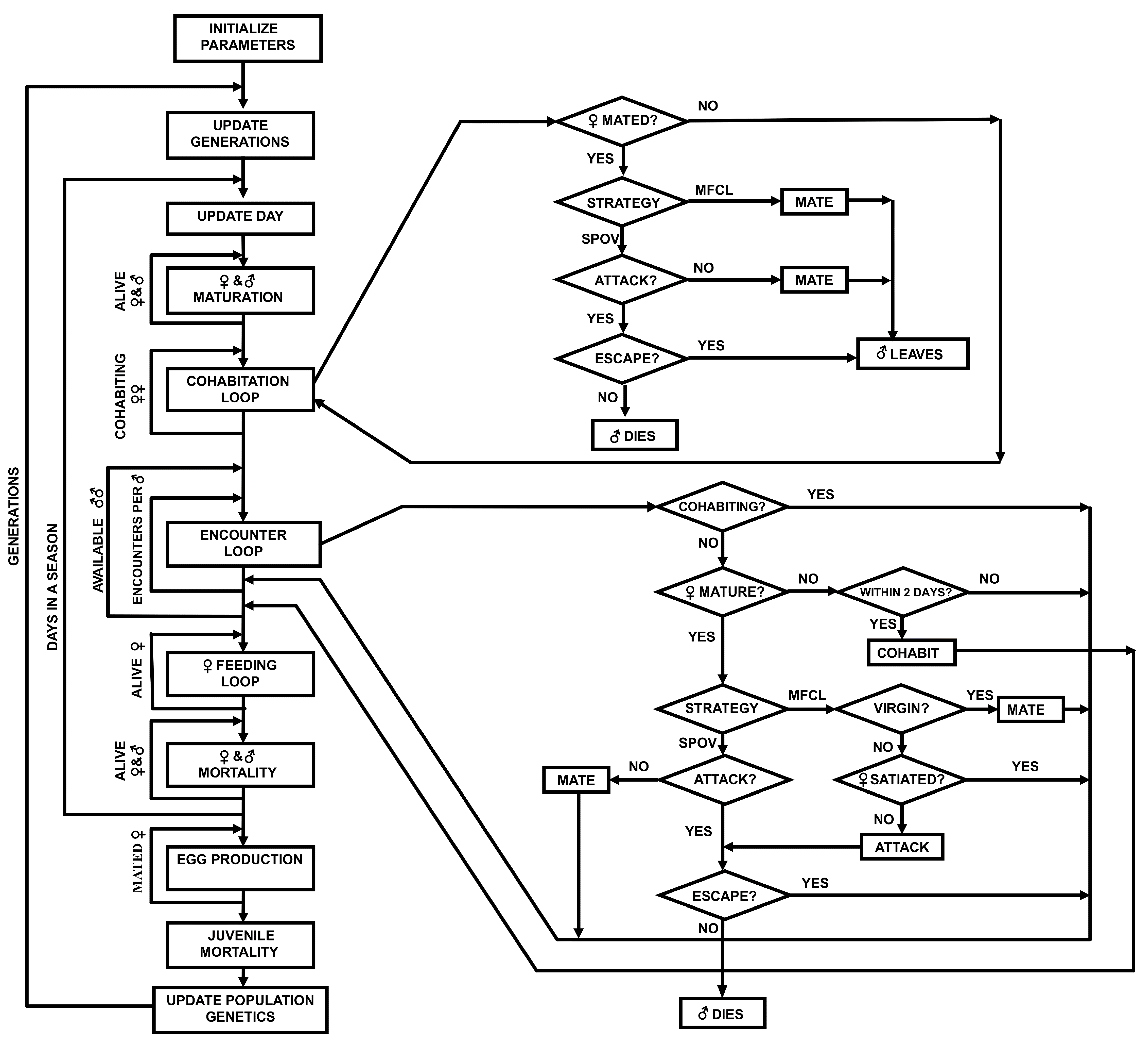
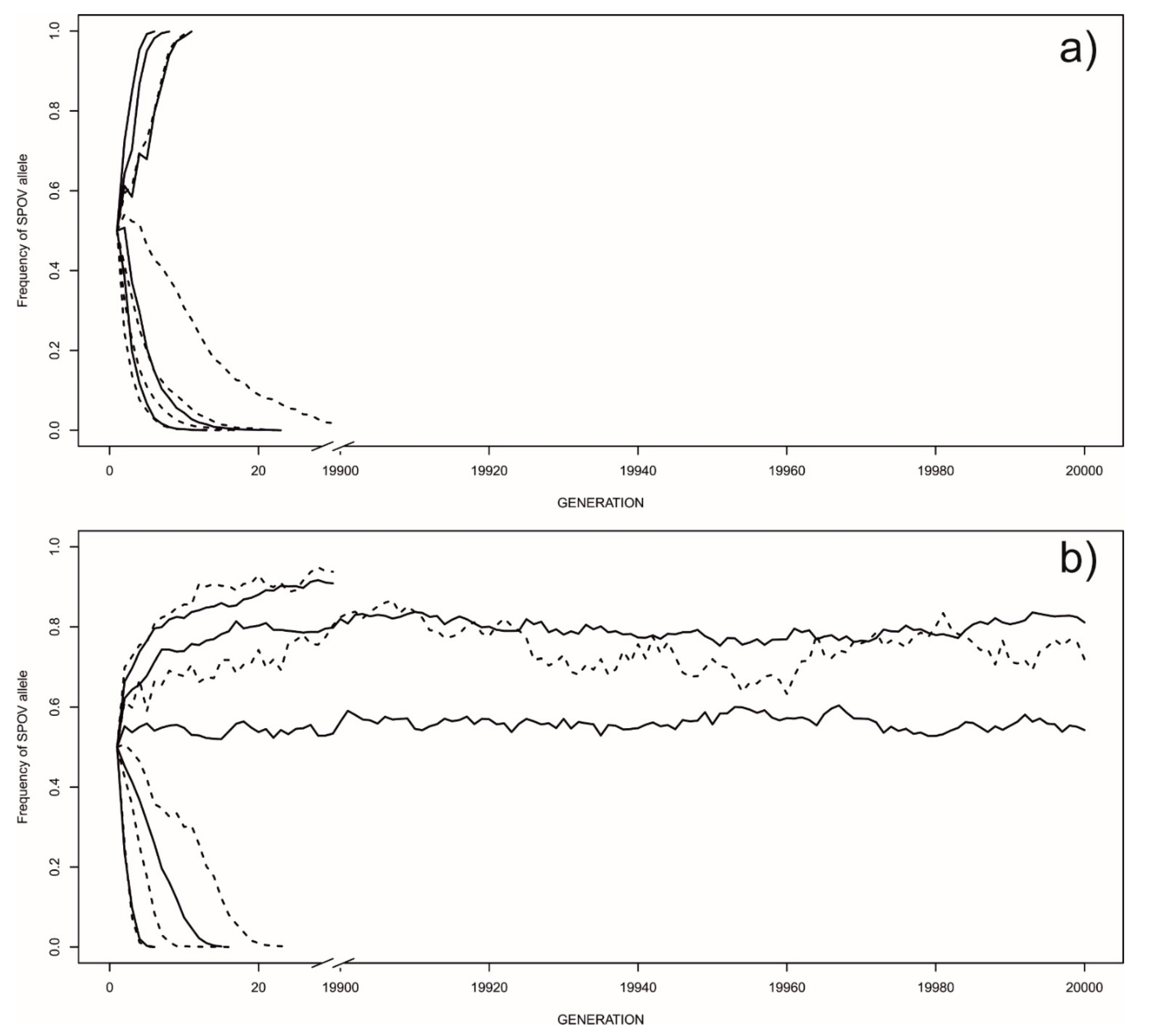
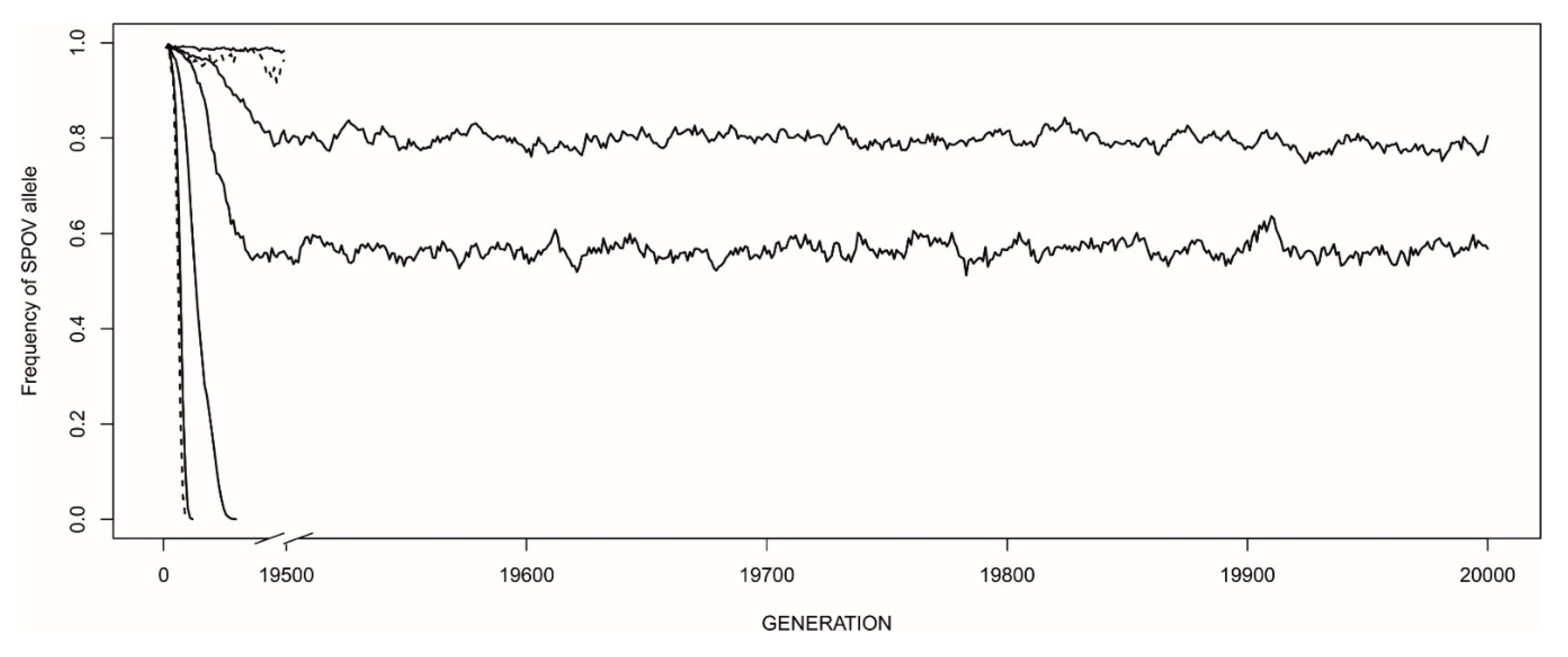
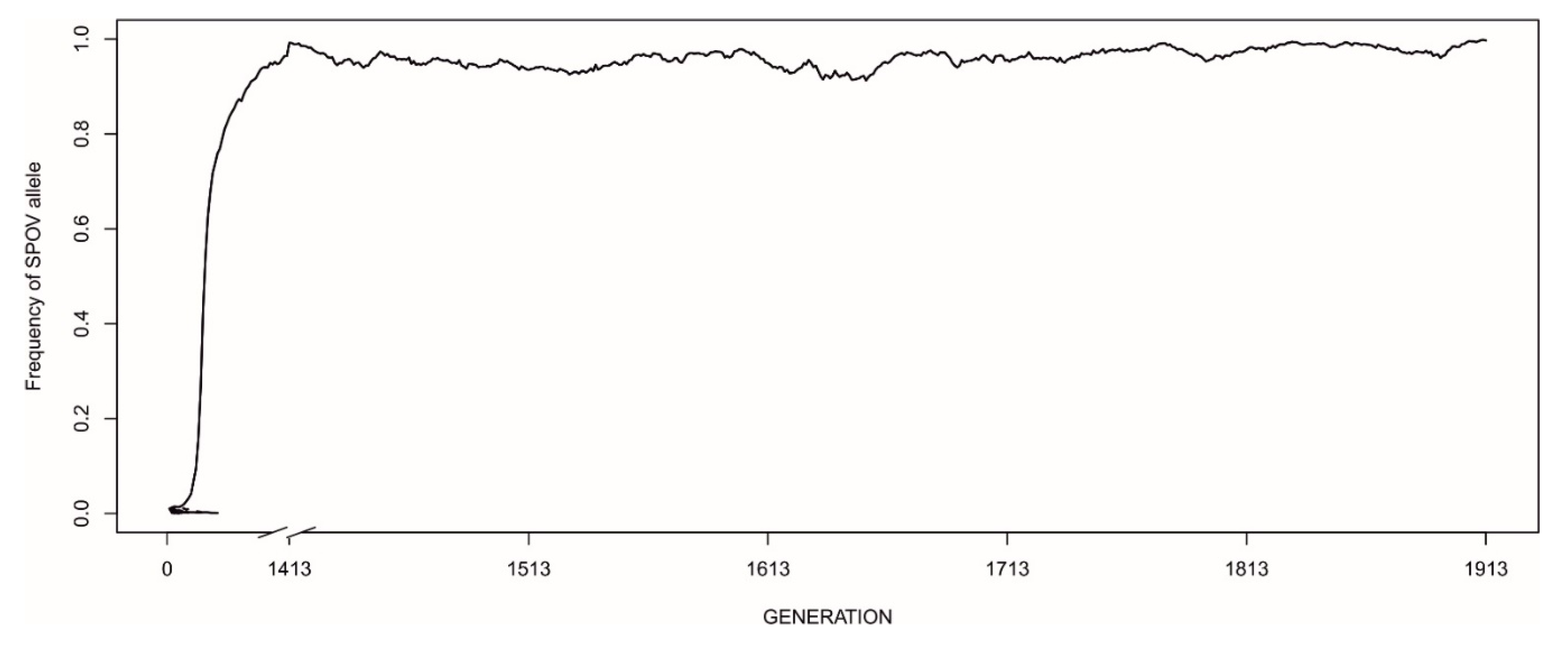
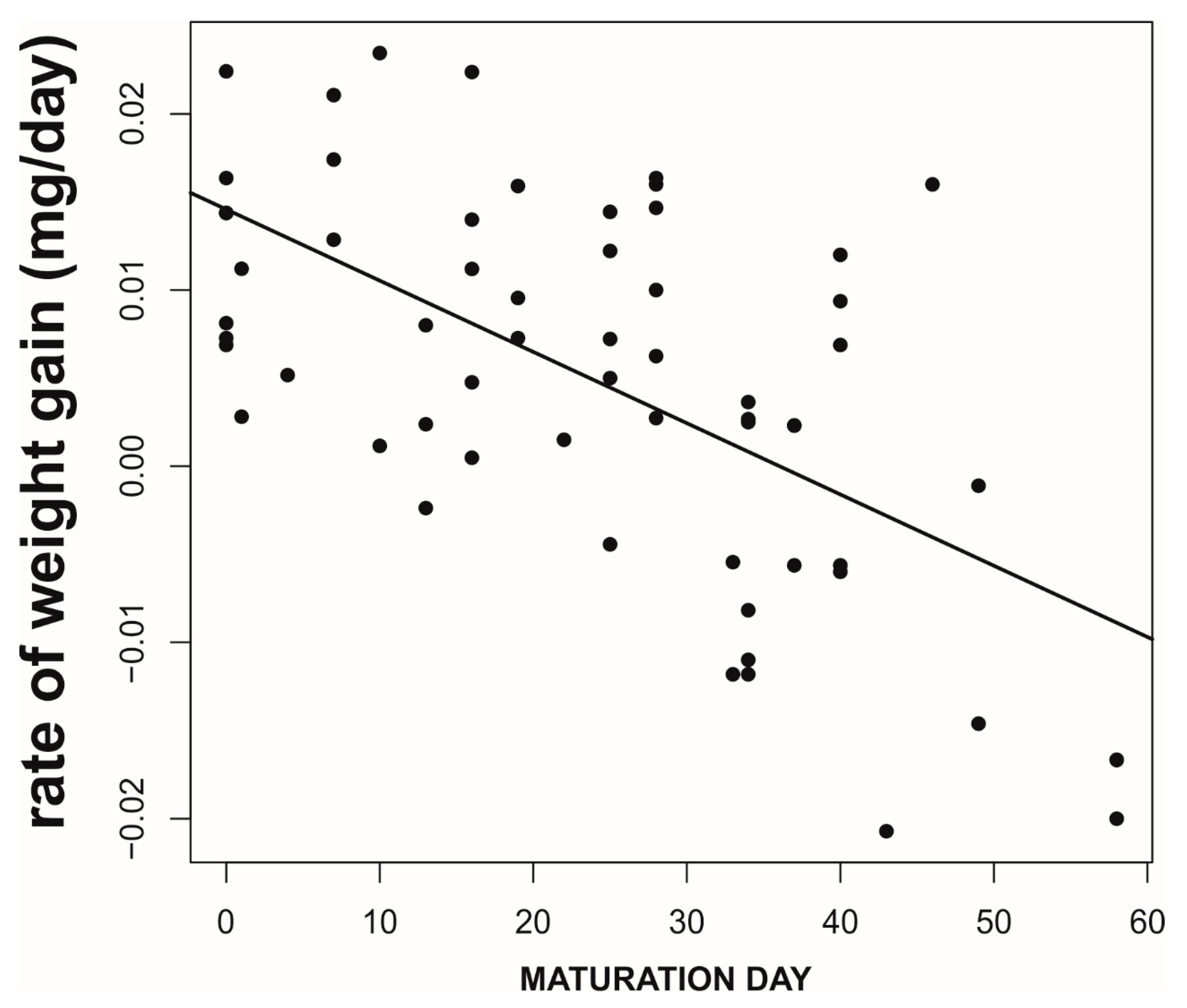
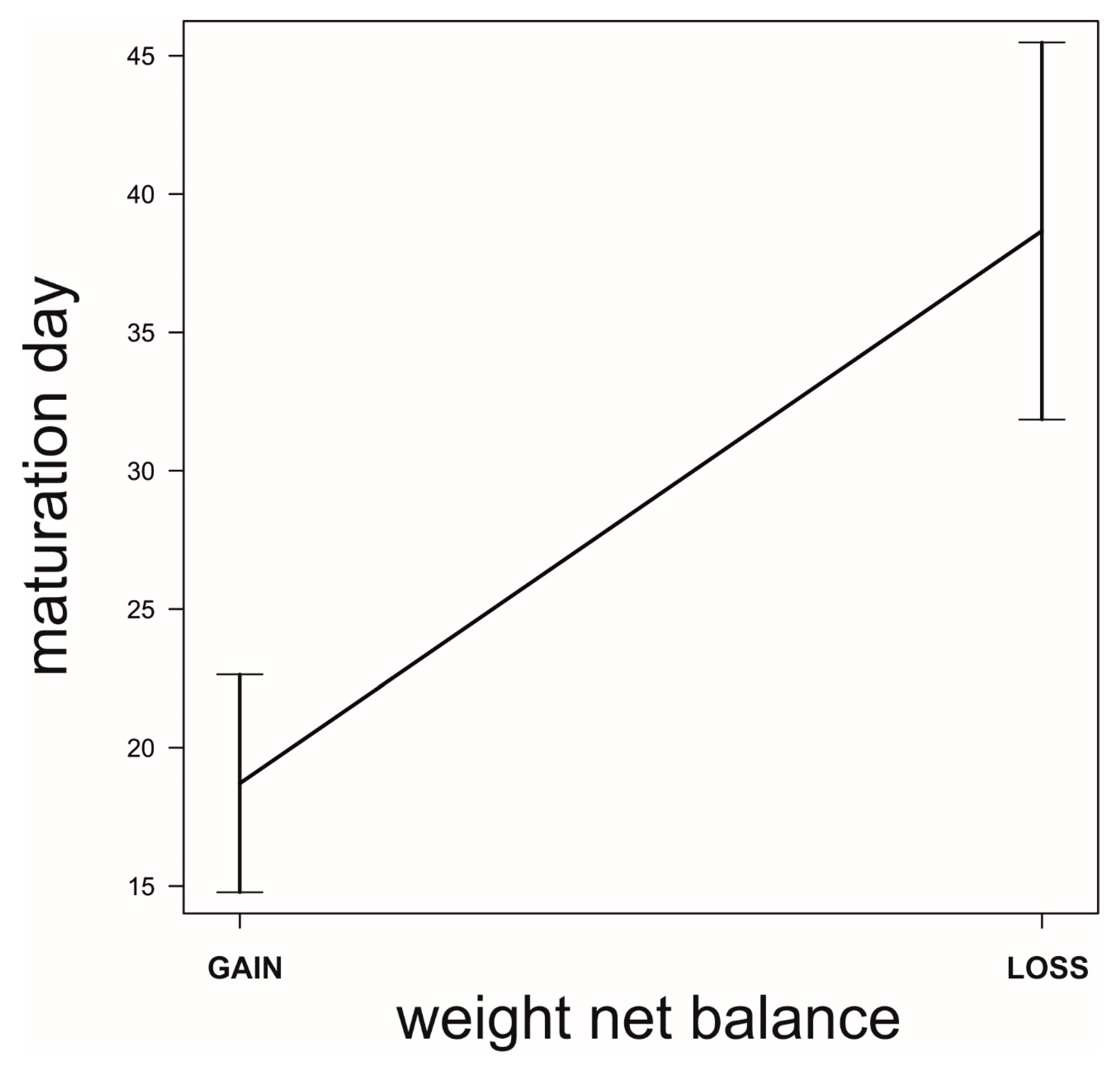
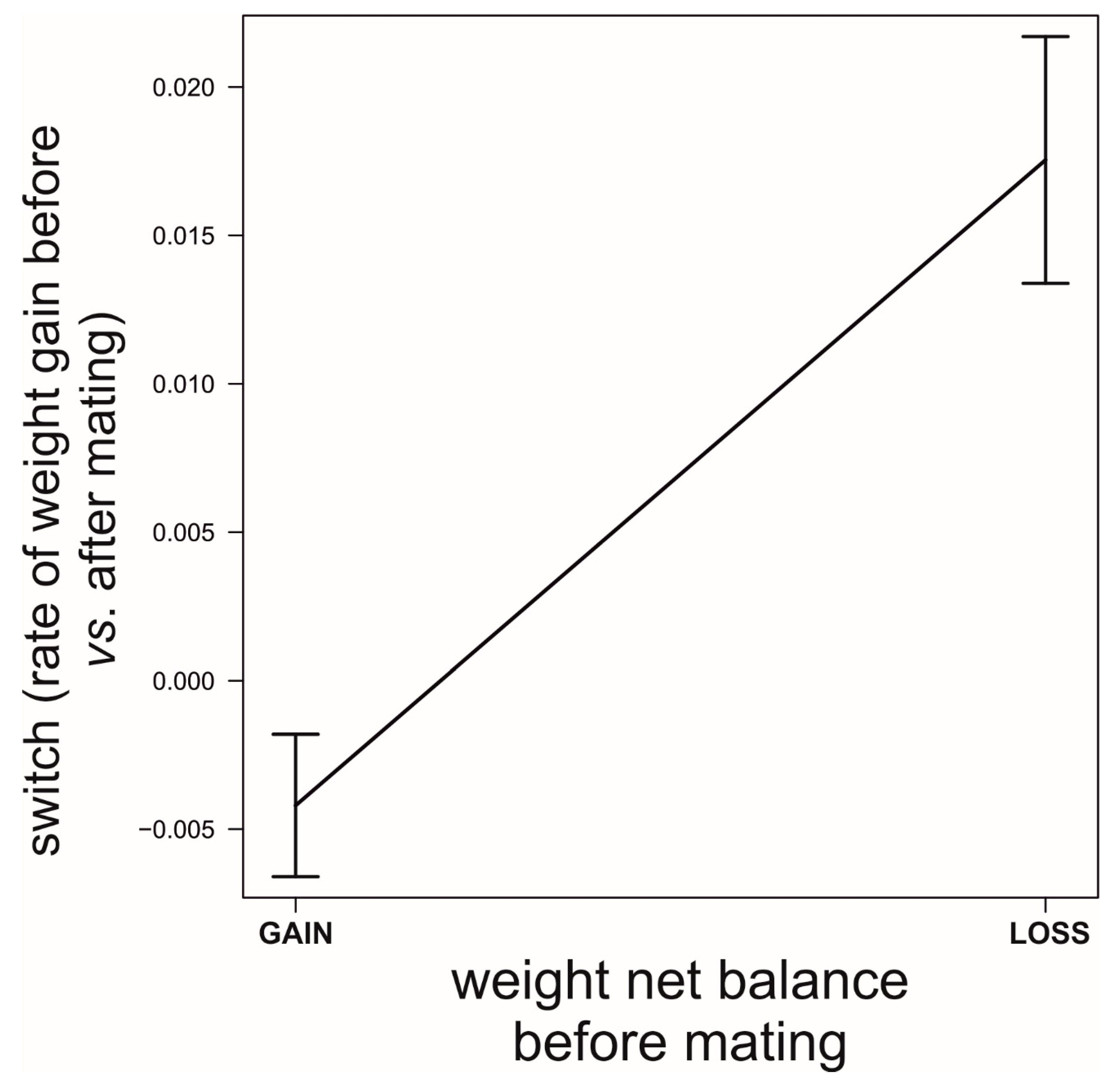
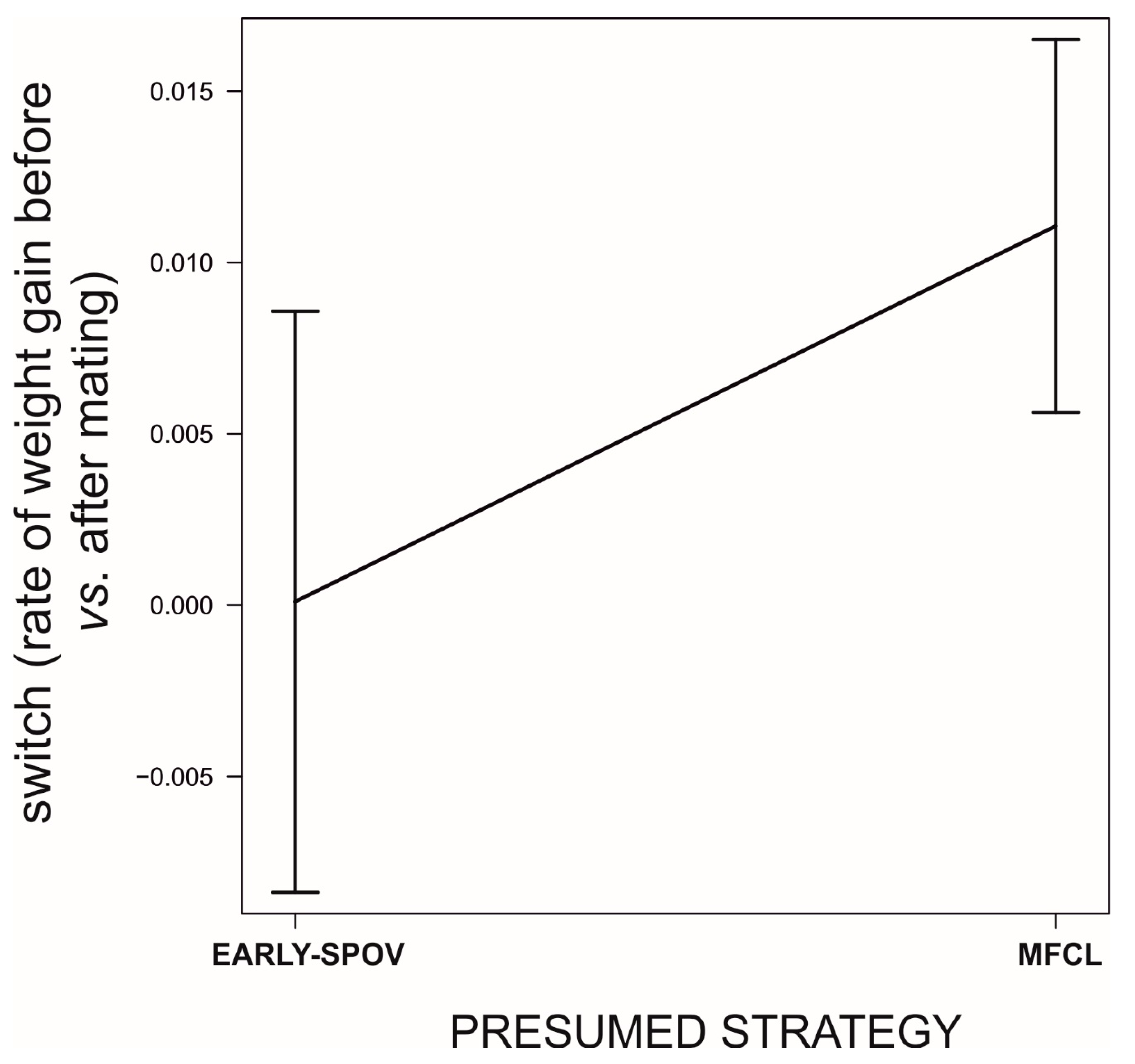
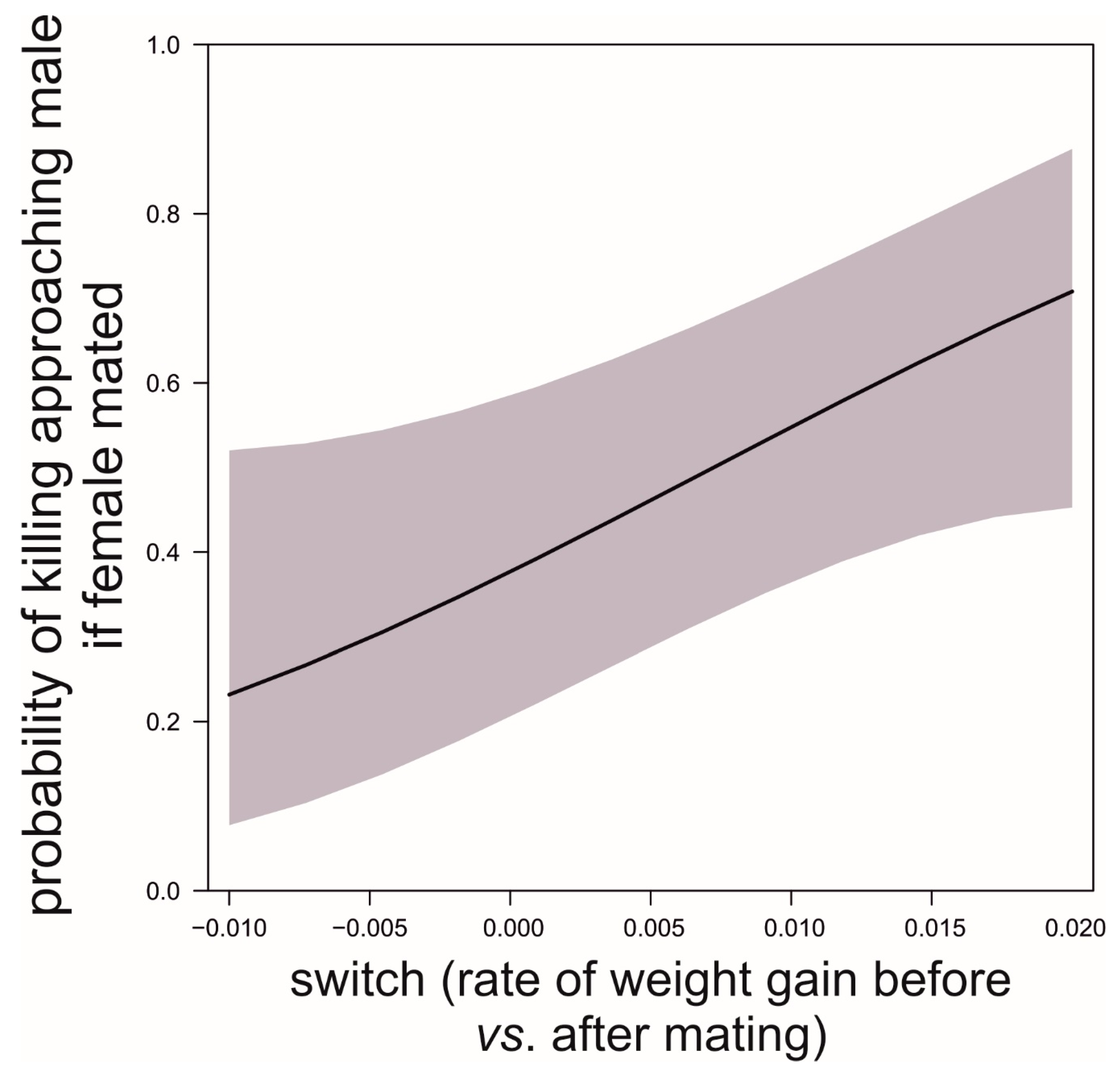
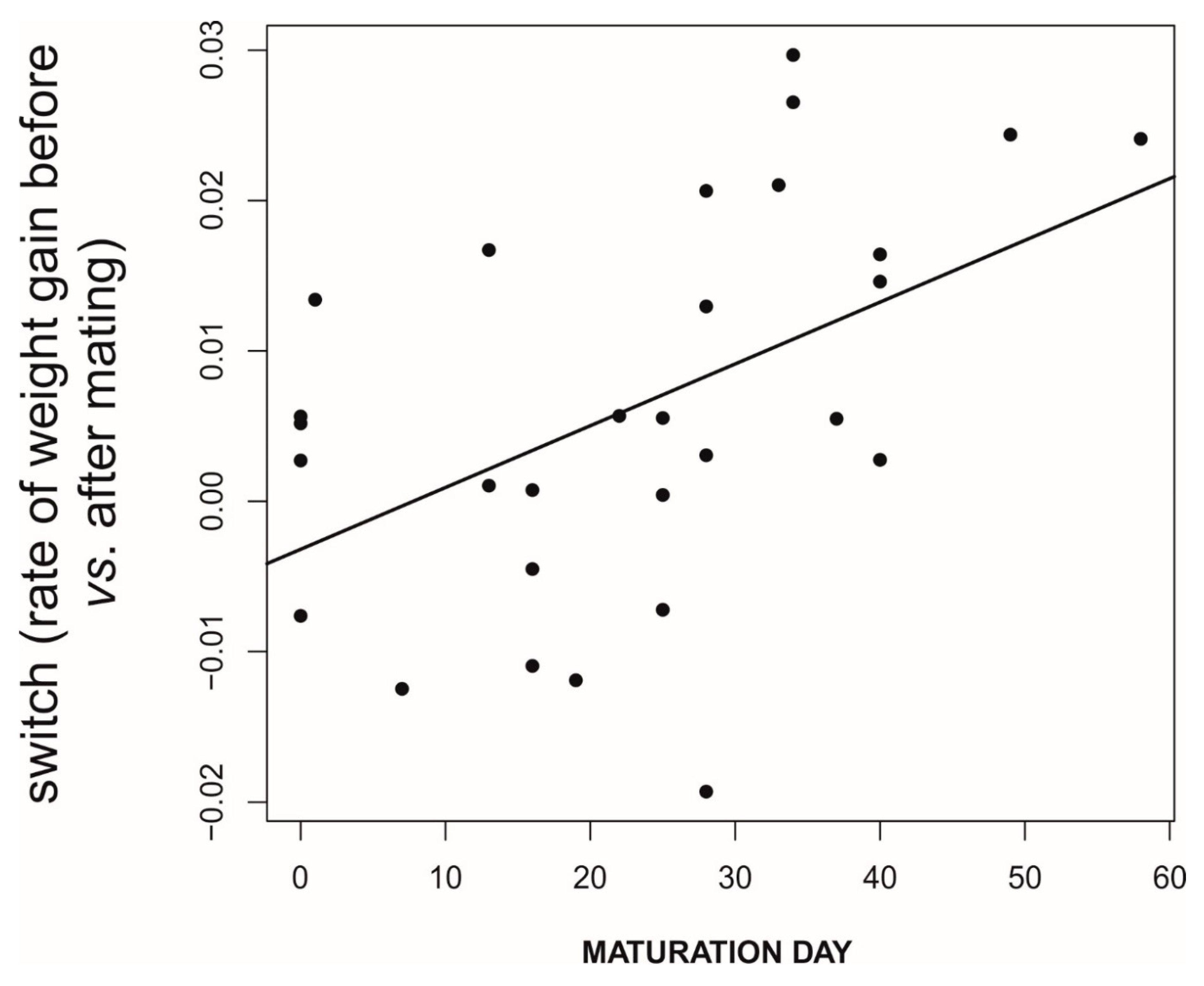
| Parameter | Value/s |
|---|---|
| Date of Season’s Onset | April 23rd |
| Season length | 79 days |
| Background female mortality rate for MFCL | 0.0030 day−1 |
| Background female mortality rate for SPOV, BCD-SPOV, EM-SPOV and BCD EM-SPOV * | 0.0036 day−1 |
| Background male mortality rate | 0.0045 day−1 |
| Female maturation time, “fem_mat” (since April 23rd) for SPOV, BCD-SPOV and MFCL | N|μ = 56, σ = 0.5| |
| Female maturation time, “fem_mat” (since April 23rd) for EM-SPOV and BCD EM-SPOV | N|μ = 39, σ = 0.5| |
| Male maturation time, “mal_mat” (since April 23rd) | N|μ = 36, σ = 0.5| |
| Adult body size, CW (mm) for EM-SPOV and BCD EM-SPOV | N|μ = 3.21 + 0.047 * fem_mat + 0.39 * CL, σ = 0.5066| |
| Adult body size, CW (mm) for MFCL, SPOV and BCD-SPOV | N|μ = 3.21 + 0.024 * fem_mat + 0.39 * CL, σ = 0.4679| |
| Initial condition, CONDo (mm) | N|μ = 3.54 + 0.49 * CW, σ = 0.2671| |
| Threshold level for female satiation (maxCONDf, mm) ** | −38.98 + 11.73 * CW − 0.63 * CW^2 |
| Added value on condition from feeding on a male | 2.39 mm (~0.199 g) |
| Egg sac volume, “vol” (mm3) for SPOV and EM-SPOV | N|μ = −1156.43 + 277.21 * CW, σ = 140.33 |
| Egg sac volume, “vol” (mm3) for BCD SPOV and BCD EM-SPOV | N|μ = −1156.43 + 277.21 * CW + 123.44 * maxCONDf, σ = 132.97| **** |
| Egg sac volume, “vol” (mm3) for MFCL | N|μ = −2297.64 + 217.88 * CW + 123.44 * maxCONDf, σ = 129.59| **** |
| Offspring number (“N”) | N = 57.54 + 0.16 * vol |
| Daily increase in condition (or daily net abdomen growth mm/day) for MFCL | U|0,1| * 0.1482 *** |
| Daily increase in condition (or daily net abdomen growth in mm/day) for SPOV, BCD-SPOV, EM-SPOV and BCD EM-SPOV | 1.5 * U|0,1| * 0.1482 *** |
| Maximum daily rate of encounter with females, “maxenc” | 1, 3 day−1 |
| Probability of an SPOV female attacking a male, “pspov” | 0.5, 0.9 |
| Probability of male escaping from a female attack, “pescape” | exp(−CW * 0.1) |
| Proportion of offspring surviving to maturation in SPOV, BCD-SPOV, EM-SPOV and BCD EM-SPOV relative to MFCL, “different” | 0.1, 0.3, 0.5, 0.7, 0.9 |
© 2020 by the authors. Licensee MDPI, Basel, Switzerland. This article is an open access article distributed under the terms and conditions of the Creative Commons Attribution (CC BY) license (http://creativecommons.org/licenses/by/4.0/).
Share and Cite
Moya-Laraño, J.; Rabaneda-Bueno, R.; Morrison, E.; Crowley, P.H. Model and Data Concur and Explain the Coexistence of Two Very Distinct Animal Behavioral Types. Biology 2020, 9, 241. https://doi.org/10.3390/biology9090241
Moya-Laraño J, Rabaneda-Bueno R, Morrison E, Crowley PH. Model and Data Concur and Explain the Coexistence of Two Very Distinct Animal Behavioral Types. Biology. 2020; 9(9):241. https://doi.org/10.3390/biology9090241
Chicago/Turabian StyleMoya-Laraño, Jordi, Rubén Rabaneda-Bueno, Emily Morrison, and Philip H. Crowley. 2020. "Model and Data Concur and Explain the Coexistence of Two Very Distinct Animal Behavioral Types" Biology 9, no. 9: 241. https://doi.org/10.3390/biology9090241
APA StyleMoya-Laraño, J., Rabaneda-Bueno, R., Morrison, E., & Crowley, P. H. (2020). Model and Data Concur and Explain the Coexistence of Two Very Distinct Animal Behavioral Types. Biology, 9(9), 241. https://doi.org/10.3390/biology9090241





